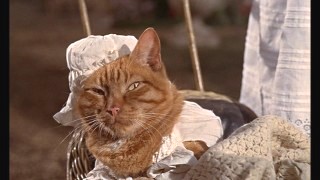While technically this came out in 1963, that was only its New York premiere; it appears to have gone into wide release in 1964. You wouldn’t have know that if I hadn’t told you, though, because this is another one of the more obscure movies that we’ve done here. As a child, I assumed it was intended to cash in on the success of Mary Poppins, as it stars the children from that movie. However, their performances in this were seen and admired enough to cast them in that instead. Still, I didn’t choose Mary Poppins for Year of the Month because I’d always said the whole point of this column was to write about the more obscure stuff and not Mary Poppins!
Mary McDhui (Karen Dotrice) is the young daughter of a widowed Scots veterinarian, Dr. Andrew McDhui (Patrick McGoohan). She has a beloved pet cat named Thomasina (several cats, which don’t look that much alike). Her father’s a bit of a hard man, not least because of the death of his wife, but he loves Mary dearly. Mary is quite popular in her set of the better-off children of the village, but her father is not quite so popular. He’s a man of science in rural Scotland in 1912—and a man who doesn’t entirely understand the attachment people have to animals. We eventually learn that he never wanted to be a veterinarian in the first place and only did because his father insisted.
Thomasina is out one night and gets injured. Mary brings her cat to her father to fix, and he does not—at least in part because he is saving the dog of a local blind man, but also because he believes Thomasina to have tetanus. He insists that his assistant, Willie Bannock (Wilfirid Brambell), put Thomasina down, not least because he himself is trying to save the life of a blind man’s dog. The children are, however, allowed to perform an elaborate funeral for Thomasina. It is interrupted by the appearance of local “witch” Lori MacGregor (Susan Hampshire), from whom the children run in fear. It turns out Thomasina isn’t quite dead, and Lori nurses her back to health. Meanwhile, Mary is so heartbroken that she begins insisting her father is dead.
It’s really an impressive performance from Dotrice. This was her first film role, and she is called on to portray a young girl in the depths of her deepest grief. I lost a cat when I was about this age, and while I’d also already lost a parent, the pain was deeper than I think a lot of people recognize. Indeed, I would argue that one of the primary themes of the movie is “people care about their pets a lot.” One of the things used to shame Dr. McDhui is that he doesn’t care about people’s pets, only about valuable livestock. That wouldn’t work if you didn’t believe that Mary really was brokenhearted about the loss of her pet.
All the children are quite good. It’s sad that Matthew Garber died so young; he was shaping up to be quite a decent actor. And the various children in the movie feel like real children. They’re going about their own lives in ways the adults don’t always understand, but they also understand the adult world a lot more—and a lot less—than they’re usually given credit for. The boys start a campaign to drive Dr. McDhui out of town without considering that Mary would have to leave, too, for example. They feel he needs to pay for what he’s done, but they don’t think the whole thing through.
Actually, there are worse vets to have caring for your animals than Andrew McDhui. It’s true that Lori is more empathetic. But it’s also true that destroying a herd because one animal in it has hoof-and-mouth disease is actually not as cruel as those without an understanding of the disease believe. The disease spreads very quickly among cattle, and it’s not implausible that multiple animals were already infected. Even today, slaughtering animals is about the only way to head off outbreaks. He worked for an hour in surgery to save a dog that could be saved—and thought to save a fifteen-year-old dog from further pain by putting it to sleep, even if that saddened its owner.
As to Thomasina, well. There’s the mystical Cat Heaven, where all the cats but her are Siamese, and somehow she awakens because nine lives. That’s beyond McDhui’s powers. I do wonder a bit about his tetanus diagnosis, given the disease tends to take ten days to show signs, but whatever; it drives the plot, at least. And after all, even Lori knows that some things are beyond her abilities and is grateful that McDhui comes to help her.
I wish the film were better known. It’s not perfect, goodness knows, but it’s still well worth watching. The Cat Heaven spot is delightful. And, yes, I like that the children live in a world that overlaps only partially with that of the adults. Some of the adults but not all of them know what’s going on; the children know some but not all of what’s going on with the adults. The children are not trusted to report animal cruelty to the police, but they are more able to discover it than the adults. It’s worth watching for a parent if nothing else as a reminder that you don’t know everything about your kids.
I bought this movie to write about, and would love to buy more; consider supporting my Patreon!

